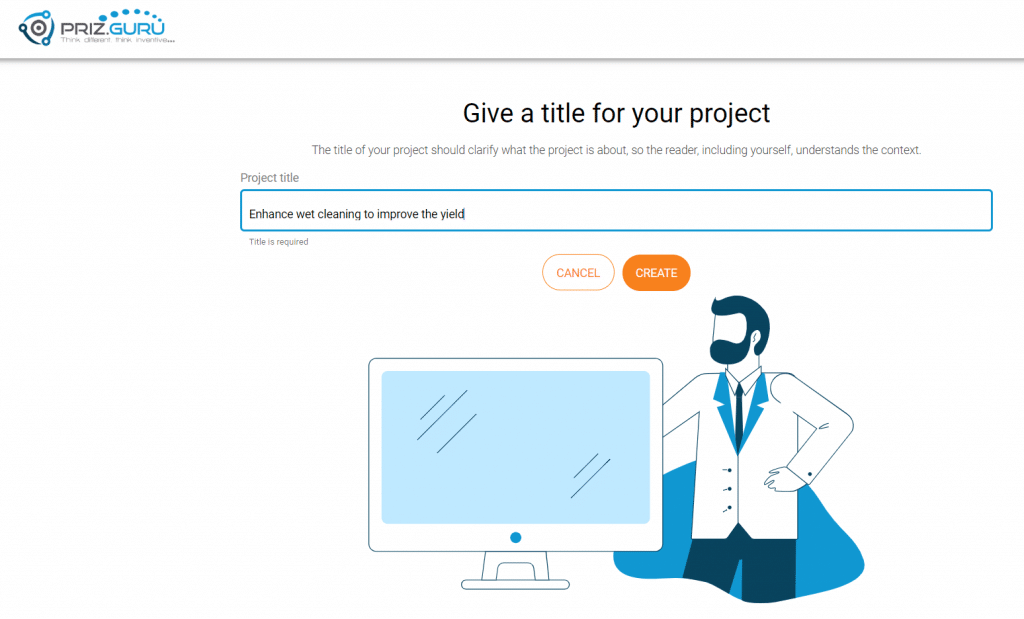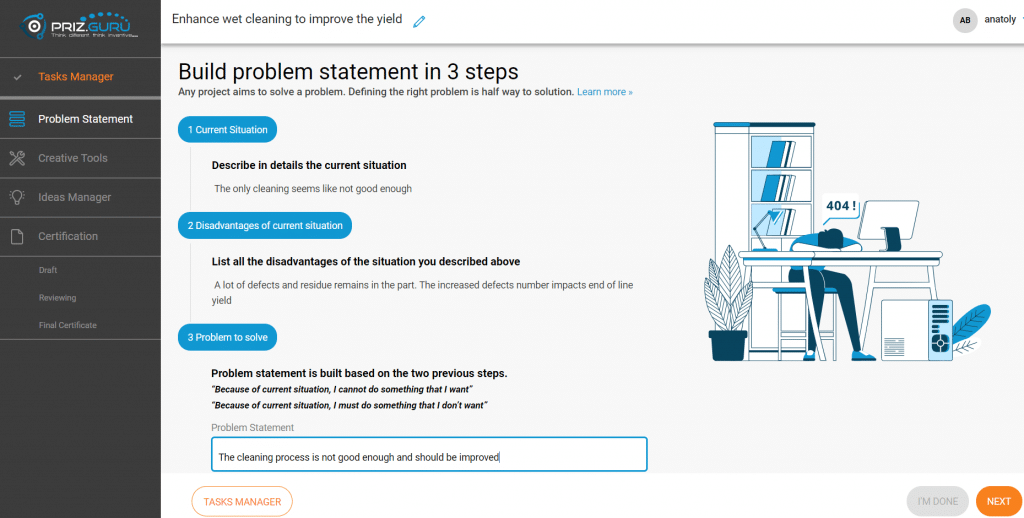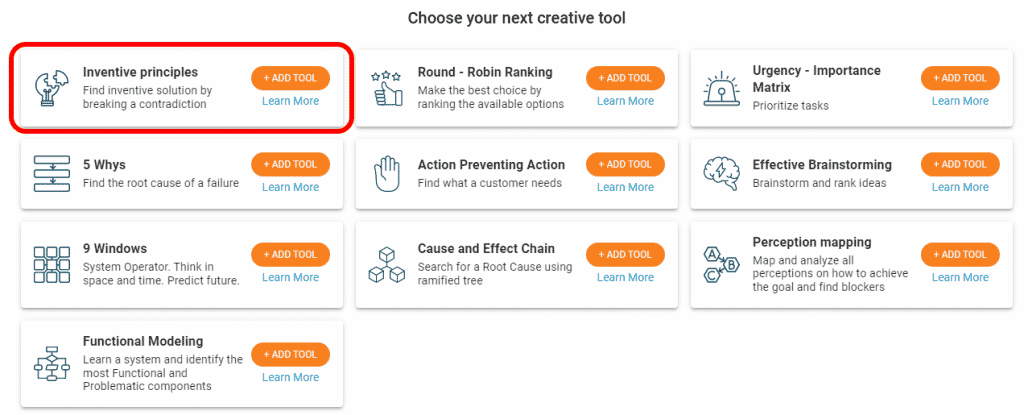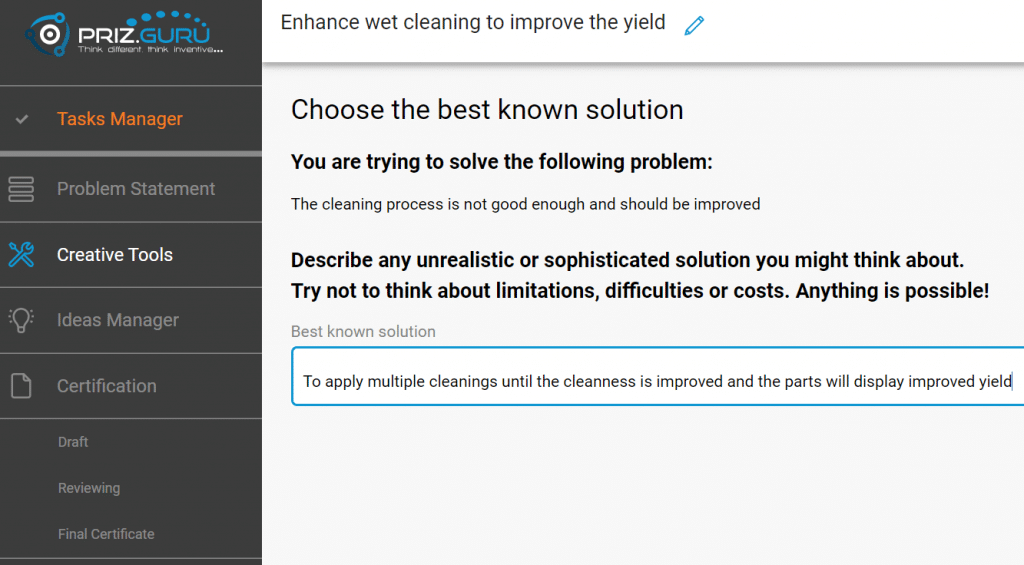This paper is about problem solving. Let’s play a game. Please follow me step-by-step.
First step: Try to invent something.
Just suggest an idea, any new idea. Not an easy task, right? You don’t know what to invent. You don’t know what you should think about.
I will try to help you to invent another query.
Second step: Try to invent something for your kitchen.
Oh, that sounds better. You can propose changing the backsplash, relocate the fridge or the microwave and so on. Why such a query sounds more helpful? Because this query focuses your thinking on your kitchen.
I can help you even more:
Third step: Try to invent something for the preparation of steaks.
Yes, it is much easier. There are many ideas. For instance, instead of preparing the stakes yourself tell the neighbors that you are going to visit them to test their barbecue. And so on and so on…
Why the innovation process becomes easier when moving from the First step to the Second step and Third? The answer is because we applied the creative thinking process. We limit your vision from very wide to the very narrow and make you focused on the subject. Hence, creative thinking forces us to focus on a certain subject, dedicate thoughts on solving the defined problem. Creative thinking tool pushes us to think about something very specific instead of about everything.
Creative thinking, or focussed thinking, enables us to solve problems and generate ideas.

40 Inventive Principles is the most effective creative thinking tool. This tool is based on the approach that all problems are already somewhere at some point solved. The solutions are documented in the general form of 40 inventive principles. The problem solver should recognize relevant principles which are general solutions and he needs to adapt them to the specific solution of the specific problem.
In problem-solving it’s extremely important to be ambitious. If you are not ambitious, we not sure you can succeed in problem-solving and in changing the world.
The flow of problem-solving with the assistance of 40 Inventive Principles is shown in the chart below:

Describe the failure, describe what bothers you. If nothing bothers you, then you have no problems, and you have no drivers to make a development.
Define the problem to solve based on what bothers you. Please remember – a problem is not what you see, a problem is what makes you change your plans and impacts your life.
Define the best-known solution (BKS). Any problem has a solution. Describe BKS even if it is not feasible or seems impossible.
In most cases, a BKS is not feasible because it may consist of some actions that cannot be completed and actually destroys the solution. However, concentrating on BKS will help you formulate a relevant contradiction.
Define an engineering contradiction. A contradiction is a sentence consists of “IF”, “THEN” and “BUT”. Read the BKS and define a contradiction. IF we do something, THEN something will be improved, BUT something else will be worsened. Since you created the contradiction, you are at least 70% on the way to the solution.
Using your contradiction, find a specific improving and worsening parameters. Assign general improving and worsening parameters that are relevant to specific parameters.
Hence, the choice of general parameters will navigate you to Inventive Principles that relevant to your problem based on the 40 Inventive Principles matrix. Please remember, you’ve got such principles because someone already solved a similar type of problem. The principles help you with ideas generation. You can use these ideas and adjust them to your solution.
Use the principles as a hint for solving your problem. Read the explanation to principles and think about how these recommendations can help you to solve your problem. This is exactly the way of creative thinking. The inventive principles will focus you in a certain direction and will bring you to a brilliant solution.
Since you’ve got a brilliant solution you can have fun; your manager will like you, your family will be proud of you, you will be happy.
Let’s analyze an example.
Some company produces very expensive parts, and quality strongly depends on the cleanliness of the parts. The parts are produced by very long flow, including wet cleaning.
It is quite clear that an application of multiple cleaning instead of a single operation will increase the cleanliness, reduce the number of defects, and improve the yield.
The best way is to use PRIZ GURU Innovative Platform – ONLINE PLATFORM.
The first step is the project title; we have chosen “Enhance wet cleaning to improve the yield” and inserted into the relevant field:

Click “CREATE” and fill in descriptions of the project background.
Get to the “Problem Statement” page and fill in all three fields. The explanations inserted into the fields in the screenshot below:

Navigate to “Creative tools”, choose and click “Inventive Principles”:

By clicking “+ADD TOOL” navigate to BKS – Best Known Solution. BKS is a solution that is obvious but seems to be problematic or even not feasible due to reasonable limitations. Nevertheless, BKS creation is a very important step since it helps to create engineering contradiction.
We choose BKS as follows: “To apply multiple cleanings until the cleanness is improved and the parts will display improved yield”. The BKS is inserted into the relevant field:

This is a good BKS because it brings us directly to at least two reasonable contradictions. The contradictions related to different worsening parameters. The first contradiction can be referred to the total process time increase and the second one is referred to the total cost increase.
A contradiction is always contained in three parts starting with “IF”, “THEN” and “BUT”.
Very generally, a contradiction loos as follows:
“IF” we do something, “THEN” something will be improved, “BUT” something else will be worsened.
Let’s analyze the first contradiction: IF we apply multiple cleaning, THEN the yield will be improved, BUT the processing time will be increased.
Below is an example of how we created a contradiction by filling in relevant fields.

The contradiction we created allows us to define improving and worsening parameters.
The next step is improving the parameter definition. We took “Reliability”. Please have a look at the explanation and you will see that Reliability corresponds to the yield improvement in this case:

The next step is to define the worsening parameter. It is quite clear in our case: “Loss of Time” is exactly the parameter that is going to be affected if we apply multiple wet cleaning:

By clicking “Next,” we have got 3 principles, 3 tips that are relevant to our problem-solving. Clicking on the arrow on the right side, we were able to scroll down the list of activity areas and chose the relevant area. By the clicking on a certain area, relevant explanations and examples of the principle appear.

Pass from one principle to another, read the explanations, think and create solutions. Please believe by focusing on a certain direction of thinking you will start to generate solutions and brilliant ideas. Just read and think, think and write.
Let’s start with the principle – “Asymmetry”. After reading the explanations and thinking about how asymmetry can help us to improve the wet cleaning we have got an idea – we do not need to clean all the part. We can analyze where the main dirt is located and spend more time on the specific locations. This will allow improving the cleaning process and save time.

The second principle that was found is “Preliminary Action” – after reading the explanation we found and recorded an idea: Check which operation was prior to the cleaning. Maybe the previous operation is too dirty and did not process correctly. Maybe the previous operation can be improved to get less stuff that should be cleaned?

The third principle that the system recommended us is “Flexible Shells and Thin Films”. After reading the explanations as you can see below and thinking, we choose that the most relevant tip is “Isolate the object from the external environment…”. It sounds excellent; maybe we should think and apply the inert atmosphere or more clean atmosphere of the parts before and after the cleaning.

We recorded all the ideas and now we can get the list of the ideas in the “Ideas manager”.

Any new ideas can be added by clicking “+Add Idea” button. By clicking “Rank All Ideas,” the ideas can be prioritized using Roun Robin Ranking. In our case, the ranking is distributed as follows:

What do we get? We have got the priority of a task to improve the yield by enhancing of wet clean process. Priority action is to check prior operation completeness. The second is to analyze the parts, find the dirtiest areas, and enhance the cleaning in these areas. Besides, as a third priority task could be applied inert atmosphere for the parts before and after the cleaning.
Sounds good. Nevertheless, we analyzed only one worsening parameter – process time increase. Also, try to analyze other aspects that are going to be impacted as cost increase. surface stuff of the part affect due to multiple wet cleaning, and so on. Each version should result in a separated engineering contradiction. Try such analysis, find relevant principles, think and generate brilliant ideas.
Click on any orange button ONLINE PLATFORM and start to solve your problems with the help of our creative thinking tools.
Do not hesitate to contact us if you need assistance.
LOGIN to PRIZ Innovation Platform and start your project.
Good luck.